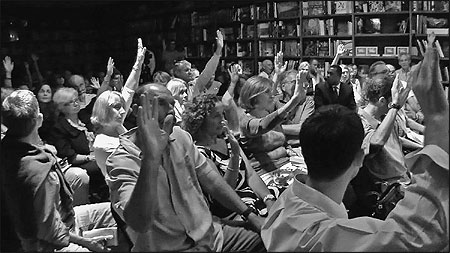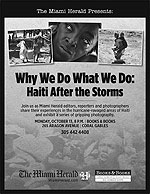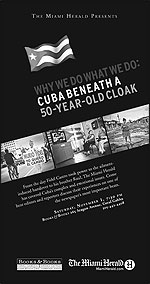The mood in the newsroom was dire. It was our second round of layoffs in less than a year and the announcement came with even more bitter news: A third round of layoffs will be coming in the first quarter of 2009. Everyone was asking themselves the same question: Why bother? Why bother working 10, 12 and sometimes—many times—14-hour days for a job that seems to be fading in an industry that is said to be dying? Why bother trying to hold together a newsroom that is already thin and getting thinner? Why bother to continue to do more with less? Why bother? After all, haven’t readers tuned us out?
As we contemplated our futures, a disaster loomed for a neighboring nation. Haiti would fall prey to four consecutive storms that claimed hundreds of lives, left thousands homeless, and turned a desperate nation into what some described as a virtual hell on earth. Many of the dead were children.
Our reports from that country—thanks to the incredible work from reporter Jacqueline Charles and photographer Patrick Farrell—resulted in an outpouring of donations. Our readers were paying attention. And their response provided an answer to an even bigger question: Why do we do what we do?
Recognizing this intersection of reader response and the reinvigoration of meaning for what we do, The Miami Herald decided to launch a new public outreach campaign: “Why We Do What We Do.” The idea is to bring our “behind the scenes” work to the public as a way of drawing attention to the journalism we do. By giving readers an opportunity to speak directly with the correspondents who gather information and those who bring us remarkable images—by making them part of a conversation—we hope to explore deeply this question of why we do what we do and perhaps emerge with renewed understanding of and appreciation for the value of what journalism provides.
Conversations Commence
Our first session took place on October 13th and featured our coverage of the devastation in Haiti. We met at Books & Books, a popular gathering spot in nearby Coral Gables, after our community events staff whipped up a promotional ad. E-mail blasts went out to book club members. Word spread. Our invitation was simple and direct:
“Why We Do What We Do: Haiti After the Storms.” Join us as Miami Herald editors, reporters and photographers share their experiences in the hurricane-ravaged areas of Haiti and exhibit a series of gripping photography.
RELATED WEB LINK
Watch a video of the first forum »We met on a Monday night, and participants were tightly packed into folded chairs squished between bookshelves. The two speakers from the Herald were the reporter and photographer who’d been in Haiti. I was the moderator. Our time together began with a three-minute presentation of photographs, video and voices. The audio conveyed the words of the storms’ victims and our correspondents, who documented the deaths of dozens of children. Their words and images described a scene so grim that even what we showed the audience could not fully capture the devastation. And we included photographs not published in our newspaper because they were deemed too disturbing—of babies torn from their parents’ arms, and stripped of their clothes by raging floodwaters, who were lying dead on a sidewalk “looking like porcelain dolls,” as the reporter described them.
Stunned silence laced with sighs of dismay greeted the film’s end as the audience waited to hear from those who’d conveyed this tragic tale. After introducing the panelists, I briefly explained why we were here. I shared with them how throughout our careers—as we’ve reported stories about corrupt politicians or infighting at the school board or a neighborhood hero—people have asked us why we do what we do. Now that the industry is hurting, I told them, many of us who do this work find ourselves asking this same question.
We were only together for an hour, but in that time plenty of good questions got asked. “How do you find out where to go to cover the story?” “How do you decide what photos to put on the front page?” “Why didn’t you include the photos you showed us tonight?” “What goes through your mind when you see such tragedy?” “Does it affect you on a personal level?” “How do you cope with your feelings?” “Why risk your own lives to tell someone else’s tale?” “When are you going back?”
What I came to realize is how much of what we do remains mysterious to those who read and view our work each day. At the same time, some of what we consider routine about what we do now could be seen by us in different and more meaningful ways.
View larger image »On November 1st, we held our second public forum. This time our focus was Cuba, soon to mark the 50th anniversary of a revolution that we are still trying to decipher. Held on a Saturday night in the same space, this one proved just as popular, with readers eager to hear about “Why We Do What We Do: Cuba Beneath a 50-Year-Old Cloak.”
Our visual opening illuminated The Miami Herald’s reporting about Cuba for five decades. This time, we could not provide as much of an on-the-ground connection to reporters and photographers who document this coverage. The reason: The Cuban government rarely grants Miami Herald correspondents visas required for journalists to gather news there. But we go anyway—getting our people there in various ways—because, in journalistic terms, this is our story. What happens there affects us in Miami, and so, as we explained that evening, we continue to cover this story as aggressively and thoroughly as any other one that is important to our community.
At this event, our panelists included the Herald’s World Editor John Yearwood, Director of Photography Luis Rios, and Cuba correspondent Frances Robles, who has perhaps the most difficult job in the newsroom: covering a foreign country from Miami and for an audience of readers who have a strong personal connection to the story. I moderated, as questions flew our way. “How hard is it to talk to people there?” “What happens if the government catches your correspondent?” “How do they get the information out once your reporter gets in?” “What changes have you seen since the Miami Herald’s last visit?” “When will you go back?”
What We Are Learning
The idea for the public campaign “Why We Do What We Do” was born out of turmoil, as a way to try to help boost morale in the newsroom and engage the public. Many people at the Herald were involved in bringing it to life—including top editors and community event organizers and, of course, the reporters and photographers who reluctantly agreed to put themselves in the spotlight.
These two public forums have been successful, attracting together more than 300 people. Perhaps the most telling measure of success has come from a question raised by audience members at both gatherings: “When is the next one?” We plan on having more of these community gatherings. They’ve served not only to enlighten the public but us, too.
While it is perhaps true that newspapers will give way, in time, to a new medium that will rely on fewer professionals to carry out the work, as this transition happens it is critical that journalists find ways to share with the public more about what they do as a way of explaining its value to them. Though I know there will be many more very long days for those of us fortunate enough to still have newsroom jobs, these forums have given me renewed energy. No longer do I enter the newsroom believing that readers have tuned us out. Perhaps it is we who have tuned them out by creating too great a distance between them and us. Whether we use words, pictures, new technology or public forums, what is clear is that connecting to readers is now a matter of survival. Now I feel more confident that we can regain what we’ve lost, one story at a time.
At The Miami Herald building these days, it is uncomfortably cold in a city known for its warmth. Our old thermostat in our even older building can’t seem to be set high enough these days to replace the heat that came from all the bodies that used to sit at now empty desks. With another blast of internal cold air due to sweep through the newsroom at some point in January, just how many more will be forced to leave is not yet known. Maybe a handful. Maybe more. Even one seems too many.
Among those who do stay will be those who contend with what I have come to call the “why bother factor.” Why bother working sometimes—many times—14-hour days for a job that seems to be increasingly maligned and fading away? Why bother trying to hold together a newsroom that appears to be dying a slow and painful death? Why pursue that next story?
As I write this piece, more Haitian children have died as a result of a school collapse from apparent shoddy construction, and more Cubans in central Cuba are now homeless due to a late-season category-3 hurricane with a peaceful name—Paloma (Dove). Our correspondents are there.
I’m hoping I make it through the next round of layoffs. And if I do, I want to remember the answer we’ve asked the public to help us arrive at to the question many of us seem to be asking: “Why do we do what we do?” We do it because it matters.

Nancy San Martin, a 2006 Nieman Fellow, is assistant world editor/Americas at The Miami Herald.





